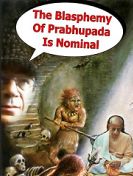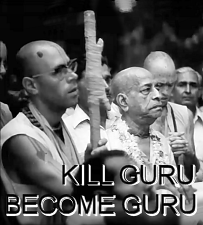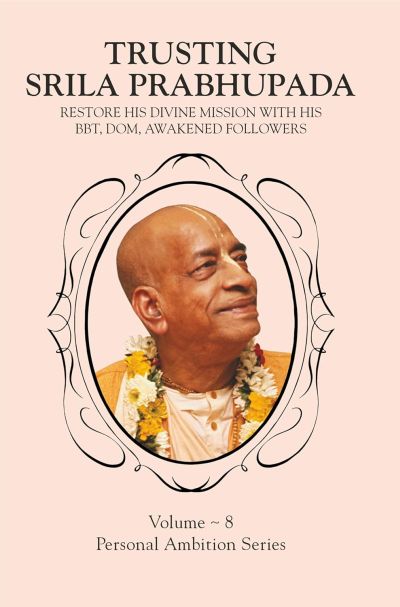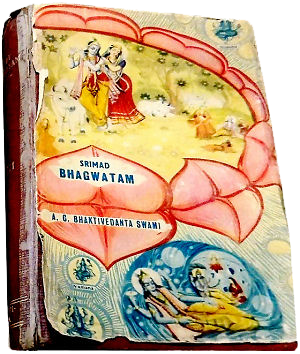Nitai Pada Kamala Vaishnavas [AUDIO]
Srila Prabhupada describes the exalted glories to Sri Nityananda Prabhu
NITĀI-PADA-KAMALA
The Lotus Feet of Lord Nityānanda
By Śrīla Narottama dāsa Ṭhākura
nitāi-pada-kamala, koṭi-candra-suśītala,
je chāyāy jagata jurāy
heno nitāi bine bhāi, rādhā-kṛṣṇa pāite nāi,
dṛḍha kori’ dharo nitāir pāy
se sambandha nāhi jā’r, bṛthā janma gelo tā’r,
sei paśu boro durācār
nitāi nā bolilo mukhe, majilo saṁsāra-sukhe,
vidyā-kule ki koribe tār
ahaṅkāre matta hoiyā, nitāi-pada pāsariyā,
asatyere satya kori māni
nitāiyer koruṇā habe, braje rādhā-kṛṣṇa pābe,
dharo nitāi-caraṇa du’khāni
nitāiyer caraṇa satya, tāṅhāra sevaka nitya,
nitāi-pada sadā koro āśā
narotamma boro dukhī, nitāi more koro sukhī,
rākho rāṅgā-caraṇera pāśa
Translation:
1. The lotus feet of Sri Nityananda are as cool as millions of moons. The whole universe gets peace by the shade of those lotus feet. Without the mercy of Sri Nityananda, nobody can get Radha and Krishna, the aim of human life. Therefore, catch hold of the two lotus feet of Sri Nityananda Prabhu very tightly.
2. One who has not established a relationship with Sri Nityananda is a two-legged animal. A great beast! His whole life is finished. He cannot be called a human being. He never utters the name of Sri Nityananda. He is always immersed in enjoying material happiness and has forgotten Sri Nitai. He may have acquired all material scholarship and learning, but what is the value of such education? This will never help.
3. They are so puffed up with their mundane education and scholarship. They are never humble at all. They have forgotten the lotus feet of Sri Nitai because of their false ego and pride. They are completely under the clutches of Maya. They accept the untruth as truth. If Sri Nityananda showers His mercy upon someone, he will get Sri Sri Radha Krishna in Vrajabhumi. So catch hold of the two lotus feet of Lord Nityananda very tightly.
4. The lotus feet of Sri Nityananda are eternally true. And those followers or servants of those lotus feet of Sri Nityananda are also eternal. Always aspire for the lotus feet of Sri Nityananda. Srila Narottama dasa Thakura says, “I am very distressed, and an unhappy person. I am drowning in this dreadful ocean of material existence. 0 Sri Nityananda Prabhu, please make me very happy! Please keep me at Your lotus feet.”
Adi-Lila Chapter 5 The Glories of Lord Nityānanda Balarāma (CC 1975)
This chapter is chiefly devoted to describing the essential nature and glories of Śrī Nityānanda Prabhu. Lord Śrī Kṛṣṇa is the absolute Personality of Godhead, and His first expansion in a form for pastimes is Śrī Balarāma.
Beyond the limitation of this material world is the spiritual sky, paravyoma, which has many spiritual planets, the supreme of which is called Kṛṣṇaloka. Kṛṣṇaloka, the abode of Kṛṣṇa, has three divisions, which are known as Dvārakā, Mathurā and Gokula. In that abode the Personality of Godhead expands Himself into four plenary portions-Kṛṣṇa, Balarāma, Pradyumna (the transcendental Cupid) and Aniruddha. They are known as the original quadruple forms.
In Kṛṣṇaloka is a transcendental place known as Śvetadvīpa or Vṛndāvana. Below Kṛṣṇaloka in the spiritual sky are the Vaikuṇṭha planets. On each Vaikuṇṭha planet a four-handed Nārāyaṇa, expanded from the first quadruple manifestation, is present. The Personality of Godhead known as Śrī Balarāma in Kṛṣṇaloka is the original Saṅkarṣaṇa (attracting Deity), and from this Saṅkarṣaṇa expands another Saṅkarṣaṇa, called Mahā-saṅkarṣaṇa, who resides in one of the Vaikuṇṭha planets. By His internal potency, Mahā-saṅkarṣaṇa maintains the transcendental existence of all the planets in the spiritual sky, where all the living beings are eternally liberated souls. The influence of the material energy is conspicuous there by its absence. On those planets the second quadruple manifestation is present.
Outside of the Vaikuṇṭha planets is the impersonal manifestation of Śrī Kṛṣṇa, which is known as the Brahmaloka. On the other side of the Brahmaloka is the spiritual kāraṇa-samudra, or Causal Ocean. The material energy exists on the other side of the Causal Ocean, without touching it. In the Causal Ocean is Mahā-Viṣṇu, the original puruṣa expansion from Saṅkarṣaṇa. This Mahā-Viṣṇu places His glance over the material energy, and by a reflection of His transcendental body He amalgamates Himself within the material elements.
As the source of the material elements, the material energy is known as pradhāna, and as the source of the manifestations of the material energy it is known as māyā. But material nature is inert in that she has no independent power to do anything. She is empowered to make the cosmic manifestation by the glance of Mahā-Viṣṇu. Therefore the material energy is not the original cause of the material manifestation. Rather, the transcendental glance of Mahā-Viṣṇu over material nature produces that cosmic manifestation.
Mahā-Viṣṇu again enters every universe as the reservoir of all living entities, Garbhodakaśāyī Viṣṇu. From Garbhodakaśāyī Viṣṇu expands Kṣīrodakaśāyī Viṣṇu, the Supersoul of every living entity. Garbhodakaśāyī Viṣṇu also has His own Vaikuṇṭha planet in every universe, where He lives as the Supersoul or supreme controller of the universe. Garbhodakaśāyī Viṣṇu reclines in the midst of the watery portion of the universe and generates the first living creature of the universe, Brahmā. The imaginary universal form is a partial manifestation of Garbhodakaśāyī Viṣṇu.
In the Vaikuṇṭha planet in every universe is an ocean of milk, and within that ocean is an island called Śvetadvīpa, where Lord Viṣṇu lives. Therefore this chapter describes two Śvetadvīpas-one in the abode of Kṛṣṇa and the other in the ocean of milk in every universe. The Śvetadvīpa in the abode of Kṛṣṇa is identical with Vṛndāvana-dhāma, which is the place where Kṛṣṇa appears Himself to display His loving pastimes. In the Śvetadvīpa within every universe is a Śeṣa form of Godhead who serves Viṣṇu by assuming the form of His umbrella, slippers, couch, pillows, garments, residence, sacred thread, throne and so on.
Lord Baladeva in Kṛṣṇaloka is Nityānanda Prabhu. Therefore Nityānanda Prabhu is the original Saṅkarṣaṇa, and Mahā-saṅkarṣaṇa and His expansions as the puruṣas in the universes are plenary expansions of Nityānanda Prabhu.
In this chapter the author has described the history of his leaving home for a personal pilgrimage to Vṛndāvana and his achieving all success there. In this description it is revealed that the author’s original paternal home and birthplace were in the district of Katwa, in the village of Jhāmaṭapura, which is near Naihāṭī. Kṛṣṇadāsa Kavirāja’s brother invited Śrī Mīnaketana Rāmadāsa, a great devotee of Lord Nityānanda, to his home, but a priest named Guṇārṇava Miśra did not receive him well, and Kṛṣṇadāsa Kavirāja Gosvāmī’s brother, not recognizing the glories of Lord Nityānanda, also took sides with the priest. Therefore Rāmadāsa became sorry, broke his flute and went away. This was a great disaster for the brother of Kṛṣṇadāsa Kavirāja Gosvāmī. But on that very night Lord Nityānanda Prabhu Himself graced Kṛṣṇadāsa Kavirāja Gosvāmī in a dream and ordered him to leave on the next day for Vṛndāvana.
A few selected verses from Adi-Lila chapter 5 (1975):
Ādi 5.1
TEXT 1vande ‘nantādbhutaiśvaryaṁ
śrī-nityānandam īśvaram
yasyecchayā tat-svarūpam
ajñenāpi nirūpyateSYNONYMS
vande—let me offer my obeisances; ananta—unlimited; adbhuta—and wonderful; aiśvaryam—whose opulence; śrī-nityānandam—unto Lord Nityānanda; īśvaram—the Supreme Personality of Godhead; yasya—whose; icchayā—by the will; tat-svarūpam—His identity; ajñena—by the ignorant; api—even; nirūpyate—can be ascertained.TRANSLATION
Let me offer my obeisances to Lord Śrī Nityānanda, the Supreme Personality of Godhead, whose opulence is wonderful and unlimited. By His will, even a fool can understand His identity.
TEXT 2
jaya jaya śrī-caitanya jaya nityānanda
jayādvaita-candra jaya gaura-bhakta-vṛndaSYNONYMS
jaya jaya—all glories; śrī-caitanya—to Śrī Caitanya Mahāprabhu; jaya nityānanda—all glories to Lord Nityānanda; jaya advaita-candra—all glories to Advaita Ācārya; jaya gaura-bhakta-vṛnda—all glories to the devotees of Lord Śrī Caitanya Mahāprabhu.TRANSLATION
All glories to Śrī Caitanya Mahāprabhu. All glories to Lord Nityānanda. All glories to Advaita Ācārya. And all glories to all the devotees of Lord Caitanya Mahāprabhu.
TEXT 3
ei ṣaṭ-śloke kahila kṛṣṇa-caitanya-mahimā
pañca-śloke kahi nityānanda-tattva-sīmāSYNONYMS
ei—this; ṣaṭ-śloke—in six verses; kahila—described; kṛṣṇa-caitanya-mahimā—the glories of Lord Śrī Caitanya Mahāprabhu; pañca-śloke—in five verses; kahi—let me explain; nityānanda—of Lord Nityānanda; tattva—of the truth; sīmā—the limitation.TRANSLATION
I have described the glory of Śrī Kṛṣṇa Caitanya in six verses. Now, in five verses, I shall describe the glory of Lord Nityānanda.
Ādi 5.4
TEXT 4sarva-avatārī kṛṣṇa svayaṁ bhagavān
tāṅhāra dvitīya deha śrī-balarāmaSYNONYMS
sarva-avatārī—the source of all incarnations; kṛṣṇa—Lord Kṛṣṇa; svayam—personally; bhagavān—the Supreme Personality of Godhead; tāṅhāra—His; dvitīya—second; deha—expansion of the body; śrī-balarāma—Lord Balarāma.TRANSLATION
The Supreme Personality of Godhead, Kṛṣṇa, is the fountainhead of all incarnations. Lord Balarāma is His second body.PURPORT
Lord Śrī Kṛṣṇa, the absolute Personality of Godhead, is the primeval Lord, the original form of Godhead, and His first expansion is Śrī Balarāma. The Personality of Godhead can expand Himself in innumerable forms. The forms that have unlimited potency are called svāṁśa, and forms that have limited potencies (the living entities) are called vibhinnāṁśa.
Ādi 5.5
TEXT 5
eka-i svarūpa doṅhe, bhinna-mātra kāya
ādya kāya-vyūha, kṛṣṇa-līlāra sahāyaSYNONYMS
eka-i—one; svarūpa—identity; doṅhe—both of Them; bhinna-mātra kāya—only two different bodies; ādya—original; kāya-vyūha—quadruple expansions; kṛṣṇa-līlāra—in the pastimes of Lord Kṛṣṇa; sahāya—assistance.TRANSLATION
They are both one and the same identity. They differ only in form. He is the first bodily expansion of Kṛṣṇa, and He assists in Lord Kṛṣṇa’s transcendental pastimes.PURPORT
Balarāma is a svāṁśa expansion of the Lord, and therefore there is no difference in potency between Kṛṣṇa and Balarāma. The only difference is in Their bodily structure. As the first expansion of Godhead, Balarāma is the chief Deity among the first quadruple forms, and He is the foremost assistant of Śrī Kṛṣṇa in His transcendental activities.
Ādi 5.6
TEXT 6sei kṛṣṇa—navadvīpe śrī-caitanya-candra
sei balarāma—saṅge śrī-nityānandaSYNONYMS
sei kṛṣṇa—that original Kṛṣṇa; navadvīpe—at Navadvīpa; śrī-caitanya-candra—Lord Śrī Caitanya Mahāprabhu; sei balarāma—that Lord Balarāma; saṅge—with Him; śrī-nityānanda—Lord Nityānanda.TRANSLATION
That original Lord Kṛṣṇa appeared in Navadvīpa as Lord Caitanya, and Balarāma appeared with Him as Lord Nityānanda.
Ādi 5.7
TEXT 7saṅkarṣaṇaḥ kāraṇa-toya-śāyī
garbhoda-śāyī ca payobdhi-śāyī
śeṣaś ca yasyāṁśa-kalāḥ sa nityā-
nandākhya-rāmaḥ śaraṇaṁ mamāstuSYNONYMS
saṅkarṣaṇaḥ—Mahā-saṅkarṣaṇa in the spiritual sky; kāraṇa-toya-śāyī—Kāraṇodakaśāyī Viṣṇu, who lies in the Causal Ocean; garbha-uda-śāyī—Garbhodakaśāyī Viṣṇu, who lies in the Garbhodaka Ocean of the universe; ca—and; payaḥ-abdhi-śāyī—Kṣīrodakaśāyī Viṣṇu, who lies in the ocean of milk; śeṣaḥ—Śeṣa Nāga, the couch of Viṣṇu; ca—and; yasya—whose; aṁśa—plenary portions; kalāḥ—and parts of the plenary portions; saḥ—He; nityānanda-ākhya—known as Lord Nityānanda; rāmaḥ—Lord Balarāma; śaraṇam—shelter; mama—my; astu—let there be.TRANSLATION
May Śrī Nityānanda Rāma be the object of my constant remembrance. Saṅkarṣaṇa, Śeṣa Nāga and the Viṣṇus who lie on the Kāraṇa Ocean, Garbha Ocean and ocean of milk are His plenary portions and the portions of His plenary portions.PURPORT
Śrī Svarūpa Dāmodara Gosvāmī has recorded this verse in his diary to offer his respectful obeisances to Lord Nityānanda Prabhu. This verse also appears as the seventh of the first fourteen verses of Śrī Caitanya-caritāmṛta.
Ādi 5.8
TEXT 8śrī-balarāma gosāñi mūla-saṅkarṣaṇa
pañca-rūpa dhari’ karena kṛṣṇera sevanaSYNONYMS
śrī-balarāma—Balarāma; gosāñi—the Lord; mūla-saṅkarṣaṇa—the original Saṅkarṣaṇa; pañca-rūpa dhari’-accepting five bodies; karena—does; kṛṣṇera—of Lord Kṛṣṇa; sevana—service.TRANSLATION
Lord Balarāma is the original Saṅkarṣaṇa. He assumes five other forms to serve Lord Kṛṣṇa.Ādi 5.9
TEXT 9āpane karena kṛṣṇa-līlāra sahāya
sṛṣṭi-līlā-kārya kare dhari’ cāri kāyaSYNONYMS
āpane—personally; karena—performs; kṛṣṇa-līlāra sahāya—assistance in the pastimes of Lord Kṛṣṇa; sṛṣṭi-līlā—of the pastimes of creation; kārya—the work; kare—does; dhari’-accepting; cāri kāya—four bodies.TRANSLATION
He Himself helps in the pastimes of Lord Kṛṣṇa, and He does the work of creation in four other forms.
Ādi 5.10
TEXT 10sṛṣṭy-ādika sevā,—tāṅra ājñāra pālana
‘śeṣa’-rūpe kare kṛṣṇera vividha sevanaSYNONYMS
sṛṣṭi-ādika sevā—service in the matter of creation; tāṅra—His; ājñāra—of the order; pālana—execution; śeṣa-rūpe—the form of Lord Śeṣa; kare—does; kṛṣṇera—of Lord Kṛṣṇa; vividha sevana—varieties of service.TRANSLATION
He executes the orders of Lord Kṛṣṇa in the work of creation, and in the form of Lord Śeṣa He serves Kṛṣṇa in various ways.PURPORT
According to expert opinion, Balarāma, as the chief of the original quadruple forms, is also the original Saṅkarṣaṇa. Balarāma, the first expansion of Kṛṣṇa, expands Himself in five forms: (1) Mahā-saṅkarṣaṇa, (2) Kāraṇābdhiśāyī, (3) Garbhodakaśāyī, (4) Kṣīrodakaśāyī, and (5) Śeṣa. These five plenary portions are responsible for both the spiritual and material cosmic manifestations. In these five forms Lord Balarāma assists Lord Kṛṣṇa in His activities. The first four of these forms are responsible for the cosmic manifestations, whereas Śeṣa is responsible for personal service to the Lord. Śeṣa is called Ananta, or unlimited, because He assists the Personality of Godhead in His unlimited expansions by performing an unlimited variety of services. Śrī Balarāma is the servitor Godhead who serves Lord Kṛṣṇa in all affairs of existence and knowledge. Lord Nityānanda Prabhu, who is the same servitor Godhead, Balarāma, performs the same service to Lord Gaurāṅga by constant association.
Ādi 5.11
TEXT 11sarva-rūpe āsvādaye kṛṣṇa-sevānanda
sei balarāma—gaura-saṅge nityānandaSYNONYMS
sarva-rūpe—in all these forms; āsvādaye—tastes; kṛṣṇa-sevā-ānanda—the transcendental bliss of serving Kṛṣṇa; sei balarāma—that Lord Balarāma; gaura-saṅge—with Gaurasundara; nityānanda—Lord Nityānanda.TRANSLATION
In all the forms He tastes the transcendental bliss of serving Kṛṣṇa. That same Balarāma is Lord Nityānanda, the companion of Lord Gaurasundara.
Ādi 5.12
TEXT 12saptama ślokera artha kari cāri-śloke
yāte nityānanda-tattva jāne sarva-lokeSYNONYMS
saptama ślokera—of the seventh verse; artha—the meaning; kari—I do; cāri-śloke—in four verses; yāte—in which; nityānanda-tattva—the truth of Lord Nityānanda; jāne—one knows; sarva-loke—all over the world.TRANSLATION
I have explained this seventh verse in four subsequent verses. By these verses all the world can know the truth about Lord Nityānanda.
Ādi 5.13
TEXT 13māyātīte vyāpi-vaikuṇṭha-loke
pūrṇaiśvarye śrī-catur-vyūha-madhye
rūpaṁ yasyodbhāti saṅkarṣaṇākhyaṁ
taṁ śrī-nityānanda-rāmaṁ prapadyeSYNONYMS
māyā-atīte—beyond the material creation; vyāpi—all-expanding; vaikuṇṭha-loke—in Vaikuṇṭhaloka, the spiritual world; pūrṇa-aiśvarye—endowed with full opulence; śrī-catuḥ-vyūha-madhye—in the quadruple expansions (Vāsudeva, Saṅkarṣaṇa, Pradyumna and Aniruddha); rūpam—form; yasya—whose; udbhāti—appears; saṅkarṣaṇa-ākhyam—known as Saṅkarṣaṇa; tam—to Him; śrī-nityānanda-rāmam—to Lord Balarāma in the form of Lord Nityānanda; prapadye—I surrender.TRANSLATION
I surrender unto the lotus feet of Śrī Nityānanda Rāma, who is known as Saṅkarṣaṇa in the midst of the catur-vyūha [consisting of Vāsudeva, Saṅkarṣaṇa, Pradyumna and Aniruddha]. He possesses full opulences and resides in Vaikuṇṭhaloka, far beyond the material creation.PURPORT
This is a verse from Śrī Svarūpa Dāmodara Gosvāmī’s diary. It appears as the eighth of the first fourteen verses of Śrī Caitanya-caritāmṛta.
(Bhuvaneśvara, February 2, 1977)
balarāma haila nitāi
balarāma haila nitāi
asatyere satya kori māni
je chāyāy jagata jurāy
dhṛdha kori’ dharo nitāir pāy
jāniyā śuniyā biṣa khāinu
boliya janaha more
—
Hari Bol
Your Humble Servant
Nityananda Rama dasa naradhama
Srila Prabhupada describes the glories of Lord Nityananda Prabhu.
(compiled by Yasoda nandana dasa)
In Rāḍhadeśa, the part of Bengal where the Ganges is not visible, Nityānanda Prabhu, Gaṅgādāsa Paṇḍita, Murāri Gupta and Mukunda took birth
Purport
Here rāḍha-deśe refers to the village of the name Ekacakrā in the district of Birbhum, next to Burdwan. After the Burdwan railway station there is another branch line, which is called the Loop Line of the eastern railway, and there is a railway station of the name Mallārapura. Eight miles east of this railway station Ekacakrā Village is still situated. Ekacakrā Village extends north and south for an area of about eight miles. Other villages, namely Vīracandra-pura and Vīrabhadra-pura, are situated within the area of the village of Ekacakrā. In honor of the holy name of Vīrabhadra Gosvāmī, these places are renowned as Vīracandra-pura and Vīrabhadra-pura.
In the Bengali year 1331 (A.D. 1924) a thunderbolt struck the temple of Ekacakrā-grāma. Therefore the temple is now in a broken state. Before this, there were no such accidents in that quarter. Within the temple there is a Deity of Śrī Kṛṣṇa established by Śrī Nityānanda Prabhu. The name of the Deity is Baṅkima Rāya or Bāṅkā Rāya.
On the right side of Baṅkima Rāya is a Deity of Jāhnavā, and on His left side is Śrīmatī Rādhārāṇī. The priests of the temple describe that Lord Nityānanda Prabhu entered within the body of Baṅkima Rāya and that the Deity of Jāhnavā-mātā was therefore later placed on the right side of Baṅkima Rāya. Afterwards, many other Deities were installed within the temple. On another throne within the temple are Deities of Muralīdhara and Rādhā-Mādhava. On another throne are Deities of Manomohana, Vṛndāvana-candra and Gaura-Nitāi. But Baṅkima Rāya is the Deity originally installed by Nityānanda Prabhu.
On the eastern side of the temple is a ghāṭa known as Kadamba-khaṇḍī on the bank of the Yamunā, and it is said that the Deity of Baṅkima Rāya was floating in the water and Lord Nityānanda Prabhu picked Him up and then installed Him in the temple. Thereafter, in a place known as Bhaḍḍāpura, in the village of Vīracandra-pura, about half a mile west, in a place underneath a nima tree, Śrīmatī Rādhārāṇī was found. For this reason, the Rādhārāṇī of Baṅkima Rāya was known as Bhaḍḍāpurera Ṭhākurāṇī, the mistress of Bhaḍḍāpura. On another throne, on the right side of Baṅkima Rāya, is a Deity of Yogamāyā.
Now the temple and temple corridor rest on a high plinth, and on a concrete structure in front of the temple is a meeting hall. It is also said that on the northern side of the temple there was a Deity of Lord Śiva named Bhāṇḍīśvara and that the father of Nityānanda Prabhu, Hāḍāi Paṇḍita, used to worship that Deity. At present, however, the Bhāṇḍīśvara Deity is missing, and in his place a Jagannātha Svāmī Deity has been installed. Lord Nityānanda Prabhu did not factually construct any temples. The temple was constructed at the time of Vīrabhadra Prabhu. In the Bengali year 1298 (A.D. 1891), the temple being in a dilapidated condition, a brahmacārī of the name Śivānanda Svāmī repaired it.
In this temple there is an arrangement to offer foodstuffs to the Deity on the basis of seventeen seers of rice and necessary vegetables. The present priestly order of the temple belongs to the family of Gopījana-vallabhānanda, one of the branches of Nityānanda Prabhu. There is a land settlement in the name of the temple, and income from this land finances the expenditures for the temple. There are three parties of priestly gosvāmīs who take charge of the temple management, one after another. A few steps onward from the temple is a place known as Viśrāmatalā, where it is said that Nityānanda Prabhu in His childhood used to enjoy sporting with His boyfriends by enacting the rāsa-līlā and various other pastimes of Vṛndāvana.
Near the temple is a place named Āmalītalā, which is so named because of a big tamarind tree there. According to a party named the Neḍādi-sampradāya, Vīrabhadra Prabhu, with the assistance of twelve hundred Neḍās, dug a great lake of the name Śvetagaṅgā. Outside of the temple are tombs of the Gosvāmīs, and there is a small river known as the Mauḍeśvara, which is called the water of Yamunā. Within half a mile from this small river is the birthplace of Śrī Nityānanda Prabhu. It appears that there was a big meeting hall in front of the temple, but later it became dilapidated. It is now covered by banyan trees. Later on, a temple was constructed within which Gaura-Nityānanda Deities are existing. The temple was constructed by the late Prasannakumāra Kārapharmā. A tablet was installed in his memory in the Bengali year 1323 (A.D. 1916), in the month of Vaiśākha (April-May).
The place where Nityānanda Prabhu appeared is called Garbhavāsa. There is an allotment of about forty-three bighās (fourteen acres) of land to continue the worship in a temple there. The Mahārāja of Dinājapura donated twenty bighās (6.5 acres) of land in this connection. It is said that near the place known as Garbhavāsa, Hāḍāi Paṇḍita conducted a primary school. The priests of this place, listed in a genealogical table, were as follows: (1) Śrī Rāghavacandra, (2) Jagadānanda dāsa, (3) Kṛṣṇadāsa, (4) Nityānanda dāsa, (5) Rāmadāsa, (6) Vrajamohana dāsa, (7) Kānāi dāsa, (8) Gauradāsa, (9) Śivānanda dāsa and (10) Haridāsa. Kṛṣṇadāsa belonged to the Ciḍiyā-kuñja at Vṛndāvana. The date of his disappearance is Kṛṣṇa-janmāṣṭamī. Ciḍiyā-kuñja is a place now managed by the gosvāmīs of Śiṅgāra-ghāṭa in Vṛndāvana. They are also known as belonging to the Nityānanda family, most probably on the basis of their relationship with Kṛṣṇadāsa.
Near Garbhavāsa is a place called Bakulatalā, where Śrī Nityānanda Prabhu and His boyfriends used to take part in sporting activities known as jhāla-jhapeṭā. There is a bakula tree there that is wonderful because all its branches and subbranches look like the hoods of serpents. It has been suggested that by the desire of Śrī Nityānanda Prabhu, Anantadeva manifested Himself in that way. The tree is very old. It is said that formerly it had two trunks, but later on, when the playmates of Nityānanda Prabhu felt inconvenience in jumping from the branches of one trunk to those of the nother, Nityānanda Prabhu, by His mercy, merged the two trunksinto one.
Another place nearby is named Hāṅṭugāḍā. It is said that Lord Nityānanda Prabhu brought all the holy places there. Therefore the people in the surrounding villages go there instead of to the Ganges to take bath. It is named Hāṅṭugāḍā because Śrīla Nityānanda Prabhu used to perform the dadhi-ciḍā festival of distributing chipped rice with yogurt prasāda there and He took the prasāda kneeling down. A sanctified lake in this place is always full of water throughout the year. A great fair is held there during Goṣṭhāṣṭamī, and there is another big fair on the birthday of Śrī Nityānanda Prabhu. In the Gaura-gaṇoddeśa-dīpikā it is described that Halāyudha, Baladeva, Viśvarūpa and Saṅkarṣaṇa appeared as Nityānanda Avadhūta.
Sri Caitanya-caritamrta – 1975 Edition : Cc. Adi-lila : Adi 13: The Advent of Lord Sri Caitanya Mahaprabhu : Adi 13.61
After this function at the house of Śrīvāsa Ṭhākura, Nityānanda Prabhu appeared, and when He met with Lord Caitanya He got the opportunity to see Him in His six-armed form.
purport
The form of Ṣaḍ-bhuja, the six-armed Lord Gaurasundara, is a representation of three incarnations. The form of Śrī Rāmacandra is symbolized by a bow and arrow, the form of Lord Śrī Kṛṣṇa is symbolized by a stick and flute like those generally held by a cowherd boy, and Lord Caitanya Mahāprabhu is symbolized by a sannyāsa-daṇḍa and kamaṇḍalu, or waterpot.Śrīla Nityānanda Prabhu was born in the village of Ekacakra in the district of Birbhum as the son of Padmāvatī and Hāḍāi Paṇḍita. In His childhood He played like Balarāma. When He was growing up, a sannyāsī came to the house of Hāḍāi Paṇḍita, begging to have the paṇḍita’s son as his brahmacārī assistant. Hāḍāi Paṇḍita immediately agreed and delivered his son to him, although the separation was greatly shocking, so much so that Hāḍāi lost his life after the separation. Nityānanda Prabhu traveled on many pilgrimages with the sannyāsī. It is said that for many days He lived at Mathurā with him, and at that time He heard about Lord Caitanya Mahāprabhu’s pastimes in Navadvīpa. Therefore He came down to Bengal to see the Lord. When Lord Nityānanda came to Navadvīpa, He was a guest at the house of Nandana Ācārya. Understanding that Nityānanda Prabhu had arrived, Lord Caitanya sent His devotees to Him, and thus there was a meeting between Śrī Caitanya Mahāprabhu and Nityānanda Prabhu.
Sri Caitanya-caritamrta – 1975 Edition : Cc. Adi-lila : Adi 17: The Pastimes of Lord Caitanya Mahaprabhu in His Youth : Adi 17.12 :
(compiled by Nityananda Rama das)








Shri Shri Gaura-Nitāi Ki Jaya.
His Divine Grace Srila Prabhupada Ki Jaya.
We are prepping right now for the feast tomorrow!!!!